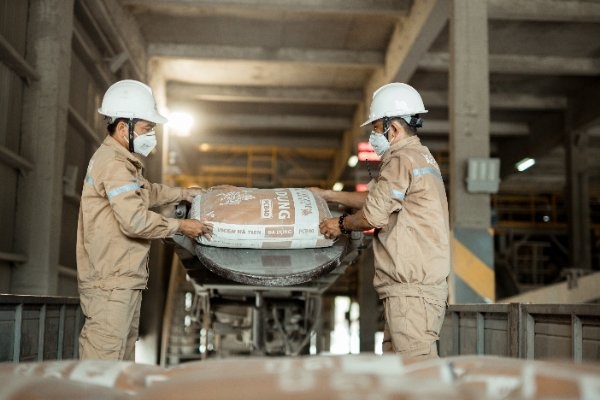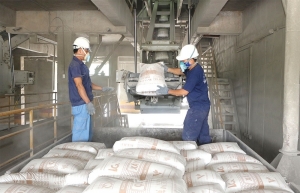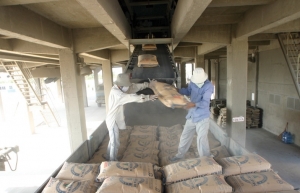Producers face up to fight in mitigating GHG emissions
Last month, state-run Vietnam Cement Industry Corporation (VICEM), one of the largest cement producers in Vietnam, released its financial assessment for 2022 and plan for 2023. While business results for 2022 were not strong as expected, the corporation is determined to concentrate power sources for projects to utilise excess heat from waste gas. The project is one of four key missions that the company targets this year.
 |
| Producers face up to fight in mitigating GHG emissions, Source:baodautu.vn |
According to the plan, by 2025, all clinker production lines with a capacity of more than 3,000 tonnes per day will be installed with power generation systems using excess heat and self-supply at least 25 per cent of the electricity demand for production.
VICEM’s cement production facilities are subject to mitigation of greenhouse gas (GHG) emissions and inventory under legislation released in January 2022. Conducting inventories by cement groups is an urgent requirement because cement production in construction is most vulnerable to long-term climate risks due to large and direct carbon emissions that require expensive decarbonisation technologies. Around 8 per cent of global carbon emissions came from cement production in 2021.
In 2020, the Vietnamese government also assigned the specific requirement to lower GHG emissions in the cement sector this decade. During this period, there should only be investment in new production plants with a capacity of not less than 5,000 tonnes per day, associated with a raw material area and funding in a power generation system that takes advantage of exhaust heat, fully satisfying indicators on the environment.
By 2025, cement plants with a capacity of less than 2,500 tonnes per day that consume many raw materials, must invest deeply in tech to improve productivity, product quality, energy saving, and environmental protection.
VICEM has developed a strategy for sustainable development to work alongside an action programme to reduce carbon emissions, which was implemented in 2017.
Other cement producers such as INSEE, Xuan Thanh Cement, and Thanh Thang Group are also implementing emissions reduction solutions. Their facilities focus on optimising technology, reducing energy consumption, and increasing use of alternative raw materials in production. Moreover, they apply new science and technology in cement production, deploying projects to utilise waste heat to generate electricity.
However during implementation, they face many challenges. Duong Ngoc Truong, deputy head of the VICEM Environmental Safety Department, said that when using waste as raw materials and alternative fuels, enterprises must assess environmental impacts and apply for environmental permits. The self-disposal of hazardous waste within the premises of waste-generating facilities must be consistent with rules on environmental impact assessment reports.
“The procedures for using excess heat to generate electricity are too complicated, and waste gas heat generation will only be implemented when it is added to the local electricity development planning,” Truong said. “The order and procedures for the handling of a number of relevant departments and branches in localities must go through many steps and take a long time to complete.”
Data from the Vietnam Environment Administration showed that Vietnam has issued licences for co-processing waste to four cement manufacturers – INSEE Hon Chong Cement; Thanh Cong Group; Nghi Son Cement Company; and VICEM Ha Tien Cement.
Associate Prof. Luong Duc Long, deputy president of the Vietnam National Cement Association, said that using waste to become alternative fuel in cement production has many advantages. Co-processing will help reduce waste storage and handling costs, reduce burial and disposal space, take advantage of heat energy, and reduce coal consumption.
“There is also economical and environmental efficiency when co-processing waste is applied in the industry. For example, it eliminates dioxin, reducing emissions,” Long said.
However, the current use rate of alternative fuels in the industry remains low.
Truong said that cement producers have yet to receive favourable supporting and encouraging mechanisms and policies in handling and treating ash, slag, synthetic gypsum, and sludge. For example, producers are asked to have licences of entire localities to transport waste to sites for treatment.
“In addition, the amount of waste does not meet the demand, and the quality in terms of size and technical requirements is not stable. It is necessary to buy garbage from many sources without support from the state, so the goal is to increase the quality,” Truong said.
 | Vietnam’s cement producers strive to deal with excess Vietnam’s cement industry is anticipating an oversupply issue as a result of China’s reopening and lower coal prices. |
 | Cement exports under duress from neighbours The removal of a levy on imported cement in the Philippines could encourage Vietnamese exporters to engage in new ventures alongside Thailand. |
What the stars mean:
★ Poor ★ ★ Promising ★★★ Good ★★★★ Very good ★★★★★ Exceptional
Related Contents
Latest News
More News
- Businesses ramp up production as year-end orders surge (December 30, 2025 | 10:05)
- Vietjet chairwoman awarded Labour Hero title (December 29, 2025 | 13:06)
- How to unlock ESG value through green innovation (December 29, 2025 | 10:03)
- AI reshapes media and advertising industry (December 29, 2025 | 08:33)
- FPT and GELEX sign deal to develop blockchain tech for global markets (December 29, 2025 | 08:29)
- Vietnam’s GDP forecast to grow by 9 per cent in 2026 (December 29, 2025 | 08:29)
- Women entrepreneurs are key to Vietnam’s economic growth (December 29, 2025 | 08:00)
- Vietnam's top 500 value-creating enterprises announced (December 27, 2025 | 08:00)
- The PAN Group shaping a better future with ESG strategy (December 26, 2025 | 09:00)
- Masan Consumer officially lists on HSX, marking the next phase of value creation (December 25, 2025 | 13:20)

 Tag:
Tag:





















 Mobile Version
Mobile Version